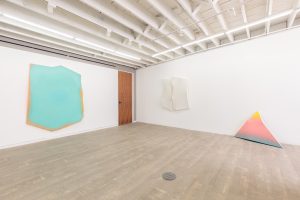Eduardo Portillo
b. 1986

Eduardo Portillo was born in El Congo, El Salvador in 1986 and currently lives and works in Houston, TX. He received a BFA in painting at the University of Houston in 2011. His work has been exhibited in numerous art venues throughout Texas including Lawndale Art Center in Houston, Blue Star Contemporary in San Antonio and recently Site 131 in Dallas. In 2013 his exhibition with the Houston Community College was included as part of the Texas Biennial. He has been awarded artist residencies with the Universidad de Ciencias y Artes de Chiapas as well as the Vermont Studio Center.
Portillo’s paintings conduct a negotiation between the literal edges and the surface of the pictorial plane, realizing his personal desire to deviate from the rectilinear into real space. The juxtaposition is established between what is considered a painting and what is categorized as a sculpture, subverts the allotted space each is normally given. In this way, his work breathes life into these ordinarily lifeless areas, celebrating the tension between implied capacity and imposed boundary.
Eduardo Portillo has always been captivated with lines, ones that define boundaries and the ones that connect across them. As an immigrant, the borders that divided his country from others,and the lines that connected where he grew up to where he lives now, have had a deep impact on his life. In his early artistic practice Portillo liked to cross the imaginary division that separated painting and sculpture. So it was almost inevitable that he would devise his own practice, stepping out of line to subvert our traditional definitions of paintings (flat and contained) and sculpture (three dimensional form on a pedestal). From there Portillo began building irregular shaped frames, seamlessly pulling and stretching the canvas over the protruding shapes. As his practice has matured, his art has become more resonantly organic, pushing out at overt angles into physical topography while still holding a highly defined geometric volume. Without right angles or a level surface he is exceeding boundaries in an objective way, exploringculture, geography and society by creating abstractions that complement themselves by theirshapes.


